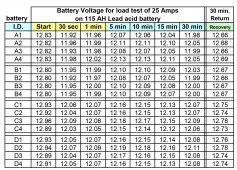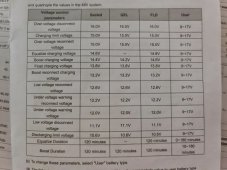there is 4080 ah of storage?
Just noticed this bit now that we're talking 48V. You only have 4S6P; 6 * 170Ah = 1,020Ah of storage.
6 months is a long time for lead acids in various states of charge to sit for 6 months not being floated.
VRLA (SLA/AGM/GEL) tend to lose < 3%/month. The 12.5-12.6V measured when taken out of storage suggests they were at >80% charge after 6 months. Not ideal, but not terrible.
They are sealed so no water can be added. Sealed Lead Acid, SLA.
They are currently getting 22A.
It depends on the manufacturer, but generally, 0.06 - 0.15C is a safe range. 170Ah * 6 = 1020Ah
Based on the provided battery cyclic specification, they want 0.1C, so you should be charging the bank at a MINMUM 102A.
There is some nuance in the above. When you're in absorption mode, you're voltage limited, so it will naturally draw less amps than the above., but when below 14.4V/battery, they should be fed 102A+
Considering 4 batteries in series, is the controller taking an average of the 4 batteries instead of one battery being to high? It would have to be. They aren’t that smart I suppose. I’ll drop the charging limit.
Good idea. Charger is as smart as it needs to be. The installation is the issue.
Running these SLA to anything above 14.4V, let alone 15.0V, is potentially rapidly shortening their lives - even more likely given that they're old.
Recommend you sort the batteries as I prescribed and match within a string. For any outliers, simply take the whole string out of the bank and deal with them individually.
You need to charge individual 12V at a minmum of 17A to 14.4V and hold until the current drops to 3.4A.
Summary of issues contributing to reduced battery life:
- Imbalanced string components causing over-charge/under-charge.
- Insufficient charge current
Given that these have been in storage, recommend you conduct a "periodic boost charge" per 5.4 once you have sorted the string issues.
I assume you got these used and cheap. That's good. These likely aren't going to last that long given their age and nature (seem intended more for UPS-type operations). Even brand new, cycle life of VRLA batteries is typically not much more than 3 years (degradation from 100% to 80% rated).






